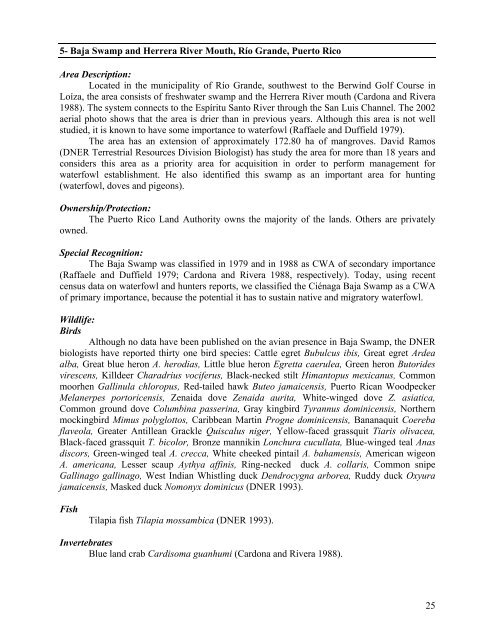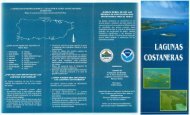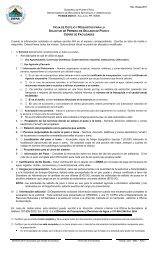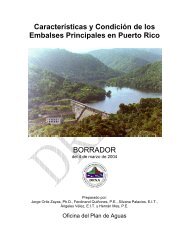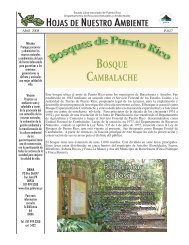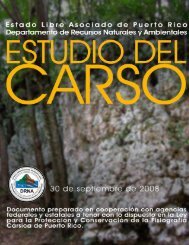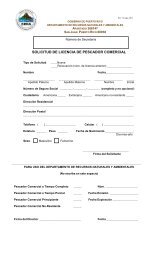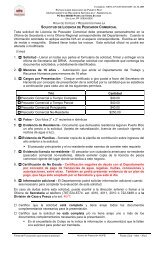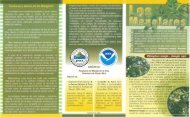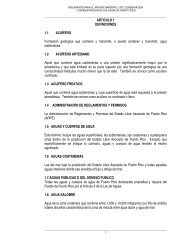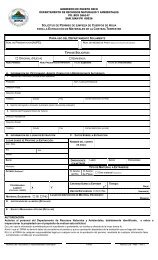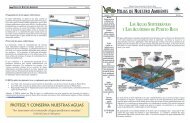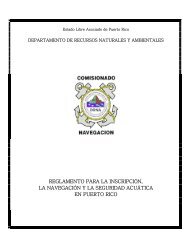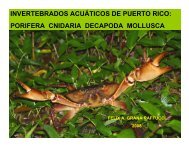- Page 1 and 2: Puerto Rico Critical Wildlife Areas
- Page 3 and 4: 19) Larga Beach and Zoní Lagoon, C
- Page 5 and 6: 67) Monito Island ……………
- Page 7 and 8: Dedicatory We honor to dedicate thi
- Page 9 and 10: Introduction After twenty years fro
- Page 11 and 12: Department of Natural and Environme
- Page 13 and 14: collaris, American Wigeon A. americ
- Page 15: Villanueva, E., L. J. Rivera-Herrer
- Page 19: Birds in the Fort Buchanan Pond The
- Page 23 and 24: designated a Natural Reserve in 197
- Page 25 and 26: in the waters that enter through th
- Page 29 and 30: 4- Barrio Borinquen, Trujillo Alto
- Page 34: Threats: This area appeared to be d
- Page 38 and 39: Columbina passerina, Mangrove cucko
- Page 40: _____. 1994. Informe de Titularidad
- Page 46 and 47: 8- Luquillo Mountains, Luquillo, Pu
- Page 48: References: Ding, M. M.; Brown, S.
- Page 52 and 53: Snowy plover C. alexandrinus, Pipin
- Page 54: Critical Plants Cobana negra Stahli
- Page 58: Reptiles Green iguana Iguana iguana
- Page 64 and 65: 12- La Cordillera Natural Reserve,
- Page 66: PRDNR. 1980. Issue Paper on Propose
- Page 69 and 70: Rico Atlas. Published in Seattle, W
- Page 71: Special Recognition: In 1979, Raffa
- Page 75 and 76: 17- Resaca Beach, Culebra, Puerto R
- Page 77 and 78: 19- Larga Beach and Zoni Lagoon, Cu
- Page 81 and 82:
20- Maillux Pond, Culebra, Puerto R
- Page 83 and 84:
References: Kapan, D.D. 2003. Avist
- Page 85 and 86:
Special Recognition: It was include
- Page 89 and 90:
25- Vieques West Coast, Vieques, Pu
- Page 91 and 92:
Birds at Kiani Lagoon Complex Forty
- Page 93:
References: Commonwealth of Puerto
- Page 97:
Pollution of the bay and surroundin
- Page 101:
References: National Oceanic and At
- Page 105 and 106:
Raffaele, H. A. 1972. Section X. Fa
- Page 108 and 109:
100
- Page 110 and 111:
heron Nyctanassa violacea, Mangrove
- Page 112 and 113:
104
- Page 114 and 115:
31- East Tip of Vieques and Conejo
- Page 116 and 117:
108
- Page 118 and 119:
32- Former Roosevelt Roads Naval Ba
- Page 120 and 121:
Biogeography of the West Indies: Pa
- Page 122 and 123:
114
- Page 124 and 125:
References: Department of Natural a
- Page 126 and 127:
118
- Page 128 and 129:
uccinator, Black-bellied whistling
- Page 130 and 131:
Bonilla, G., M. Vázquez, y E. Berr
- Page 132 and 133:
124
- Page 134 and 135:
grassquit Tiaris olivacea, Black-fa
- Page 136 and 137:
128
- Page 138 and 139:
36- Palmas Pond, Arroyo, Puerto Ric
- Page 140 and 141:
132
- Page 142 and 143:
37- Carite State Forest, Cayey, Pue
- Page 144 and 145:
Critical Plants: The endangered orq
- Page 146 and 147:
138
- Page 148 and 149:
Municipio de Cayey. 2004. Historia
- Page 150 and 151:
142
- Page 152 and 153:
closed wells indicate the presence
- Page 154 and 155:
146
- Page 156 and 157:
Zauta Lagoon is smaller than Mar Ne
- Page 158 and 159:
Antillean Oriole Icterus dominicens
- Page 160 and 161:
macropus, Saddled blenny Malacocten
- Page 162 and 163:
154
- Page 164 and 165:
41- Punta Arenas, Salinas, Puerto R
- Page 166 and 167:
158
- Page 168 and 169:
42- Salinas Training Area, Salinas,
- Page 170 and 171:
162
- Page 172 and 173:
43- Punta Petrona Mangrove and Cara
- Page 174 and 175:
166
- Page 176 and 177:
44- Cabuyón Mangrove and Fríos Ca
- Page 178 and 179:
170
- Page 180 and 181:
45- Caja de Muertos Complex, Santa
- Page 182 and 183:
References: Calderón Díaz, A. 199
- Page 184 and 185:
176
- Page 186 and 187:
Euphonia Euphonia musica, Greater A
- Page 188 and 189:
180
- Page 190 and 191:
Loxigilla portoricensis, Black-face
- Page 192 and 193:
184
- Page 194 and 195:
48- Las Salinas Lagoon / El Tuque,
- Page 196 and 197:
188
- Page 198 and 199:
49- Monte Guilarte State Forest, Ad
- Page 200 and 201:
Threats: As in other forest in Puer
- Page 202 and 203:
194
- Page 204 and 205:
Coereba flaveola, Yellow-faced gras
- Page 206 and 207:
198
- Page 208 and 209:
References: Cintrón, B.B., and B.
- Page 210 and 211:
202
- Page 212 and 213:
alternative are classified as havin
- Page 214 and 215:
Potts, F. A. 1927. Notes on Porto R
- Page 216 and 217:
208
- Page 218 and 219:
53- Guánica State Forest and Adjac
- Page 220 and 221:
Threats: In the past, part of the f
- Page 222 and 223:
214
- Page 224 and 225:
Troupial Icterus icterus, White-che
- Page 226 and 227:
218
- Page 228 and 229:
Antillean Oriole Icterus dominicens
- Page 230 and 231:
222
- Page 232 and 233:
Wildlife: Birds Puerto Rican Nightj
- Page 234 and 235:
Williams, E. H. and L. Bunkley. 199
- Page 236 and 237:
228
- Page 238 and 239:
57- Cartagena Lagoon, Lajas, Puerto
- Page 240 and 241:
White-crowned pigeon Patagioenas le
- Page 242 and 243:
Scott, Derek A., and M. Carbonell.
- Page 244 and 245:
236
- Page 246 and 247:
sandpiper C. pusilla, Western sandp
- Page 248 and 249:
240
- Page 250 and 251:
Fregata magnificens, Great blue her
- Page 252 and 253:
of the water. Other threat is the i
- Page 254 and 255:
246
- Page 256 and 257:
the refuge during the cooler months
- Page 258 and 259:
250
- Page 260 and 261:
61- Punta Guaniquilla Natural Reser
- Page 262 and 263:
Tossas Cavalliery, A.G. 2001. Lista
- Page 264 and 265:
256
- Page 266 and 267:
Wildlife Birds Fifty-two bird speci
- Page 268 and 269:
260
- Page 270 and 271:
63- Cuevas Lagoon, Cabo Rojo Area D
- Page 272 and 273:
264
- Page 274 and 275:
64- Sabanetas Swamp / Caño Boquill
- Page 276 and 277:
Invertebrates Crustacean: Blue land
- Page 278 and 279:
270
- Page 280 and 281:
65- Maricao State Forest, Mayagüez
- Page 282 and 283:
Threats: Timber harvest and managem
- Page 284 and 285:
276
- Page 286 and 287:
66- Mona Island, Puerto Rico Area D
- Page 288 and 289:
portoricensis, Caribbean Martin Pro
- Page 290 and 291:
Recently, there has been an increas
- Page 292 and 293:
Nieves, Antonio. 2005. Avistamiento
- Page 294 and 295:
286
- Page 296 and 297:
stronghold of the latter species in
- Page 298 and 299:
290
- Page 300 and 301:
68- Pozo Hondo Swamp, Añasco Area
- Page 302 and 303:
294
- Page 304 and 305:
69- Cayures Swamp / Central Coloso,
- Page 306 and 307:
298
- Page 308 and 309:
70- Desecheo Island, Puerto Rico Ar
- Page 310 and 311:
excellent physical conditions (Evan
- Page 312 and 313:
304
- Page 314 and 315:
Seca is where it meets the Guajatac
- Page 316 and 317:
308
- Page 318 and 319:
310
- Page 320 and 321:
73- Guajataca State Forest, Isabela
- Page 322 and 323:
Mammals Fig eating bat Artibeus jam
- Page 324 and 325:
316
- Page 326 and 327:
Reptiles Puerto Rican boa Epicrates
- Page 328 and 329:
320
- Page 330 and 331:
Critical Plants: There is presence
- Page 332 and 333:
324
- Page 334 and 335:
326
- Page 336 and 337:
76- Carrizales Mangrove, Hatillo Ar
- Page 338 and 339:
330
- Page 340 and 341:
77- Tiburones Swamp and La Temblade
- Page 342 and 343:
Black swift Cypseloides niger, Anti
- Page 344 and 345:
336
- Page 346 and 347:
338
- Page 348 and 349:
78- Cambalache State Forest, Arecib
- Page 350 and 351:
Gannon, M.R., M. Rodriguez-Duran, A
- Page 352 and 353:
344
- Page 354 and 355:
79- Rio Abajo State Forest, Arecibo
- Page 356 and 357:
U.S. Fish and Wildlife Service. 199
- Page 358 and 359:
mockingbird Mimus polyglottos, Nort
- Page 360 and 361:
352
- Page 362 and 363:
81- Tortuguero Lagoon, Cabo Caribe
- Page 364 and 365:
the guavinas Dormitor gobiomus and
- Page 366 and 367:
358
- Page 368 and 369:
82- Cibuco Swamp Vega Baja, Puerto
- Page 370 and 371:
References: Cardona, J. E. and S.R.
- Page 372 and 373:
364
- Page 374 and 375:
Threats: Some areas area used as il
- Page 376 and 377:
368
- Page 378 and 379:
Reptiles in the area Crested anole
- Page 380 and 381:
372
- Page 382 and 383:
374
- Page 384 and 385:
86- El Mameyal, Dorado, Puerto Rico
- Page 386 and 387:
378
- Page 388 and 389:
Fish Some species reported in the C
- Page 390 and 391:
382
- Page 392:
384


